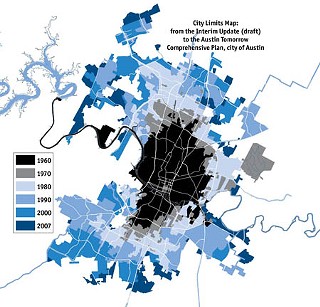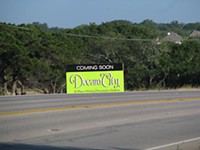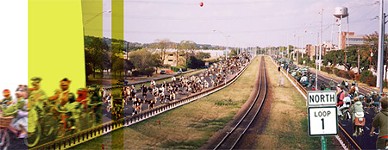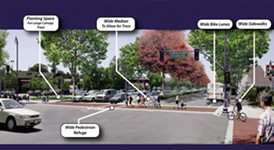Developing Stories: Million-Dollar Vision
Will council fund a fresh comprehensive planning process?
By Katherine Gregor, Fri., May 23, 2008

It's looking more and more like the city of Austin will be brave enough to embark on a fresh comprehensive plan for our collective future – if it can find the money to get started. In a proposal forwarded to City Council May 8, the Planning Commission recommended that a new long-range planning process kick off in January 2009. The implicit conviction: Austin sorely needs to get a grip on our fast-evolving future. The process proposed would offer seats at the table (or at the website) to you and all your neighbors.
The proposal details exactly how the city should pursue a fresh comprehensive plan. Council had invited this advice with its Dec. 13, 2007, resolution authorizing the Interim Update of the Austin Tomorrow Comprehensive Plan and a study of "alternative approaches" for future planning. To really get our minds around alternative scenarios for the 2010, 2020, and 2030 Austin we'll become, we'll need a full-scale planning process. The commissioners recommend: a specific timeline, to knock out the job in two years; engaging an expert consultant, estimated to cost $500,000 to $750,000 annually for budget years 2008-2009 and 2009-2010; and dedicating seven to eight full-time city Planning staffers to the project, with support from other departments. Unless new positions are created – expensive and thus unlikely – most city staff would be pulled from Neighborhood Planning, which would delay the last few neighborhood plans.
To watch during city budget conversations: Will council and staff prioritize funding for this project? Currently, it's not in the proposed 2008-2009 Neighborhood Planning and Zoning Department budget.
Austin's investment in big-picture planning has long trailed the need. It's not a frill, and it's not even optional: The City Charter includes Article X: to "establish comprehensive planning as a continuous and ongoing governmental function." Most of our peer cities thoroughly examine their long-range plans at least every five years. But Austin has not done a proper citywide update since the Austin Tomorrow Plan was finalized in 1979 – a glaring sidestep of charter requirements. What we've done instead is area-by-area neighborhood planning, without systemic goals and solutions.
Engaging Austinites
To prepare its proposal, the Planning Commission worked closely for a year with Neighborhood Planning and Zoning staff. Taking the lead is assistant director and certified planner Garner Stoll, who was hired last July for this role. (Despite its name, the department is responsible for comprehensive, not just neighborhood, planning.) The Planning Commission's Comprehensive Plan Committee examined city charter requirements, best practices from peer cities, three prior planning efforts (Austin Tomorrow, Austin Plan, and Envision Central Texas), and related issues. At a March workshop, the committee (Tracy Atkins, Chris Ewen, Paula Hui, Saundra Kirk, and Dave Sullivan) considered numerous current weaknesses and civic needs that a new plan could address, chiefly by providing better consistency and integration, which in turn could lead to cost savings.
Stoll said cities typically spend $1 million and up to engage outside consultants to lead long-range planning, because the work requires both specialized expertise and a third-party perspective. "What you want is an objective, open process," he noted, "where the public feels they've been engaged completely in a transparent process, and not driven toward one preconceived outcome. That's so important."
The peer city plans studied include the Fort Worth Comprehensive Plan (2007), Forward Dallas (2006), Blueprint Denver (2000), and Focus Kansas City (1995). Stoll said the Dallas, Denver, and Kansas City plans were led by Calthorpe Associates; in Austin, that firm led the Envision Central Texas process, the Cap Metro All Systems Go! comprehensive transit plan, the Triangle development, and other projects. "They've done some really good, innovative work with scenario testing – engaging people in thinking about their preferred vision, before people are reacting to specific plans," Stoll said. "But other groups out there are doing good work too."
Engaging Austinites fully is warmly recommended by the Planning Commission proposal, which states:
• Early, continuous, and proactive public involvement is essential.
• The process must be transparent and accessible. It must provide ample opportunities for the public to participate in all aspects of the plan's development. The process should provide continuous Web access and feedback opportunities and illustrate development options through the use of three-dimensional visual tools.
It also gives some gentle direction to the content:
• Key themes should be identified early. ... Examples of key themes might be affordable housing, neighborhood preservation, climate change, economic development, sustainability, or transit-oriented development.
• The new plan for the city of Austin must be developed within the context of the Austin region and form a basis for intergovernmental cooperation and joint implementation projects. The vision and recommendations developed for Envision Central Texas could serve as a starting point in this effort.
ECT is conducting a "vision process assessment" for its 2004 preferred growth scenario; CAMPO has caught the comprehensive long-range planning bug too and will kick off a fresh effort at meaty transportation (and related land-use) planning this summer.
Synchronicity among these efforts: all to our long-range good.
Got something to say on the subject? Send a letter to the editor.










